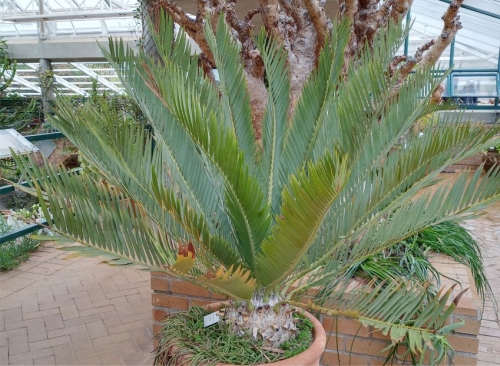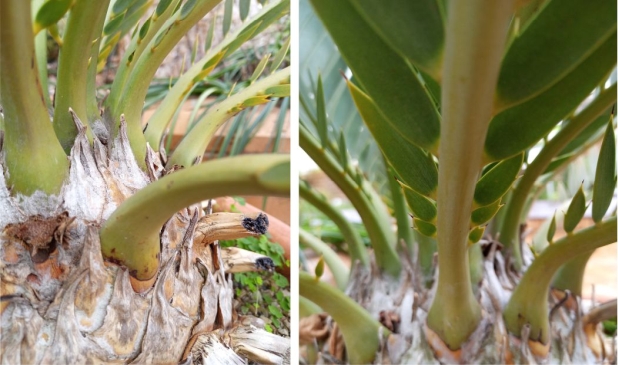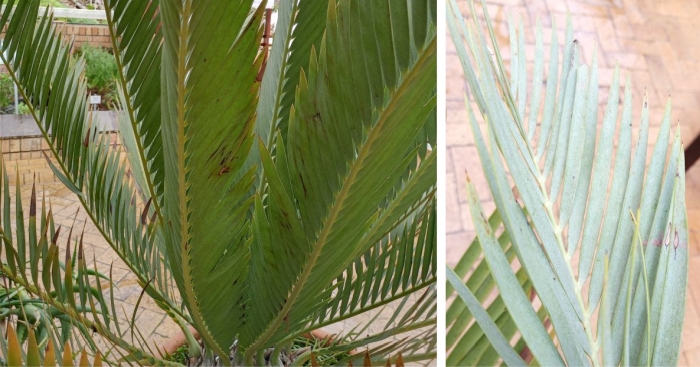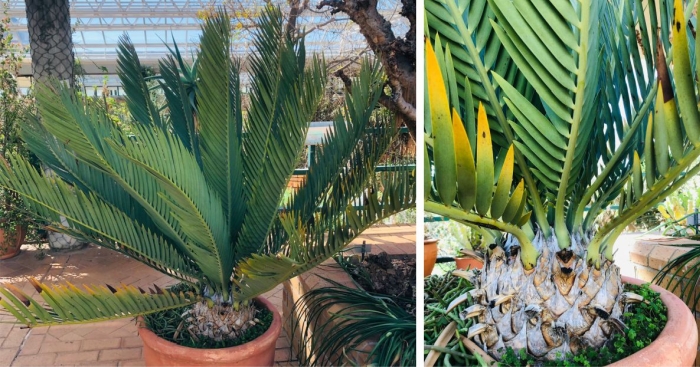Encephalartos dyerianus
Encephalartos dyerianus Lavranos & D.L.Goode
Family: Zamiaceae
Common names: Lillie’s Cycad, Lowveld Cycad (Eng.); Broodboom, Lillie-se-broodboom, Lillie-broodboom (Afr.)
SA Tree No: 14.2
Introduction
Encephalartos dyerianus is a medium-sized, bluish-green cycad with a very dense leaf canopy. This is an extremely rare cycad, and is endemic to South Africa, known from a single location in Limpopo; it grows in open grassland and shrubland on the slopes of low granite hills.

Description
Description
This cycad has an aerially unbranched stem, up to 5 m long and 500 mm in diameter. It is erect, but usually leaning to some extent, especially when tall, and usually produces suckers at the base. Much of the stem is covered by a uniform layer of leaf bases.
Leaves are rigid, pale bluish-green on both the upper and lower sides, up to 1.3 m long, curved outwards for a short distance just above leaf base and then curving gently inwards along the remainder of the leaf. Leaflets are leathery, without nodules, narrow, 170–240 mm long and 10–18 mm wide; they either do not shield one another or do so slightly at the leaf tip, incubously (when only the upper margins of the leaflets can be seen when a leaf is held horizontally and is viewed from above) and succubously in the middle part of the leaf (when only the lower margins of the leaflet can be seen when a leaf is held horizontally and is viewed from above). Leaf margins are entire and not thickened. Basal leaflets are reduced to a series of spines. Petiole is 60 mm long, curved in an s-angle at the leaf base and appear to be absent because it is largely covered with brown hairs.

Male cones are egg-shaped, 270–500 mm long and 90–120 mm in diameter, with a peduncle 100–270 mm long, blue- green but changing to yellow with maturity, up to eight cones per stem are produced in midsummer (December), with pollen shedding taking place in late summer to early autumn (February to April).
Female cones are rounded, green turning yellowish green when matured, up to five per stem, 300–600 mm long and 100–170 mm diameter, with a peduncle 60–120 mm long that is completely covered by the woolly hair of the stem apex. The cone disintegrates in winter (June to July). Seeds are light brown, 41–45 mm long, 30–37 in diameter.
Conservation Status
Status
According to the Red List of South African plants website, the conservation status of this species is Critically Endangered (CR). The population of Encephalartos dyerianus has been severely reduced due to illegal removal of mature plants for ornamental or horticultural purposes and reproductive failure may occur if more mature individuals are removed from the population. In the 1970s the population was approximately 600 plants, but was severely reduced by collectors, and currently one viable subpopulation and a few isolated individuals remain. Population decline due to illegal collecting is still ongoing it was reported that 107 plants were removed in January 2008. Furthermore, historically this species was never abundant due to a lack of seedling regeneration which is hypothetically caused by the absence of suitable insect pollinators.
Distribution and habitat
Distribution description
This cycads occurs in a small area in the eastern parts of Limpopo province. It is found on open grassland and shrubland on the slopes of low granite koppies, at elevations of 600–700 m above sea level and receives an annual rainfall of 500 mm in summer.
Derivation of name and historical aspects
History
The genus Encephalartos was described by the German botanist Johann Georg Christian Lehmann in 1834. The epithet is derived from Greek and means ‘bread in head’ and refers to the floury, starchy material in the trunks of some species, which is used as famine food by local people. The specific epithet honours Robert Allen Dyer (1900–1987), who described several southern Africa cycad species and was head of the Botanical Research Institute in Pretoria, (now the South African National Biodiversity Institute).
Cycads are the oldest known seed-bearing plants. According to the IUCN Red List in 2010, cycads are one of the most threatened groups of living organisms, where more than 60% of the ca. 300 species are classified as threatened with extinction. Cycads are often confused with both palms and tree ferns because of a superficial resemblance, however, they are actually totally unrelated. In fact, the word cycad is even derived from the Greek word cyckos meaning 'palm-like'.
Cycads are grouped into 3 families: Cycadaceae, Stangeriaceae and Zamiaceae. Currently there are about 343 species of cycad recognized worldwide. Cycads are found in the tropical, subtropical and warm temperate regions of Africa, Asia, Australia, and North and Central America. South Africa has the most cycad species in Africa, with 38 species in the genus Encephalartos, of the family Zamiaceae, and 1 species of Stangeria. South Africa also has the most threatened species: 3 species are Extinct in the Wild (EW) and 12 species have been listed as Critically Endangered (CR), and likely to soon be extinct in the wild. The main threat to South African cycads has been their removal from their natural habitat for private plant collections.
This species is closely related to and often confused with E. dolomiticus, E. eugene-maraisii, E. middelburgensis and E. nubimontanus, but it is distinguished from the other by leaves that are curved outwards for a short distance just above leaf base and then curve gently inwards along the remainder of the leaf, its very dense leaf crown and cones that are yellowish green.

Ecology
Ecology
The fleshy outer coat of the seed is eaten and the seeds dispersed by animals, mainly birds, rodents, small mammals and fruit-eating bats.
For a long time it was thought that all cycads were wind pollinated, as most coniferous plants are, and the fact that cycads generally produce high volumes of pollen, supported this argument. However, objections were raised based on the following points: species such as E. cycadifolius, E. ghellinckii, E. heenanii, E. friderici-guilielmi and E. lanatus have very woolly cones, which make it difficult for wind pollination to happen. Other cycad species such as E. villosus and Stangeria eriopus occur in forest where there is no wind. Current research shows that insects are the pollinators of all 10 cycad genera. Most cycads are thermogenic (able to produce heat) and emit volatile odours. In nature when the male cone reaches maturity, the central axis elongates and the scales move apart to make room for the release of the pollen, which is distributed by insects. The release of pollen varies between species but usually lasts for 2 weeks, on average. At the same time, the female cone also reaches maturity, the cone heats up, causing it to elongate, and it produces a smell, which attracts the insects, the pollen vectors, to the female cone. The scales move apart to allow the insects to enter and to pollinate the cone.
Uses
Use
Encephalartos dyerianus can be used as attractive decorative or focal point plants in gardens, and can also be very effective as grouped plantings with some succulents. This species has become common in private collections, but the occurrence of the wild species has declined so much, that this species can be considered to be on brink of extinction and its continued existence is uncertain. The decline of this species is partly because plants cone infrequently and it was never abundant. Therefore obtaining seeds and seedlings is difficult and expensive.

Growing Encephalartos dyerianus
Grow
Encephalartos dyerianus grows best in full sun but also tolerates light shade and is frost tolerant. This species is a slow grower, it does well in cultivation provided that it is planted in well-drained soil and does not do well with excessive moisture. It is propagated from the seeds and suckers.
In cultivation artificial pollination is necessary for a successful seed harvest. Regular visits to the male plants are necessary to note the date on which a cone appears. In this way it’s possible to estimate when the cone will be ready for harvesting. Pollen should be collected as soon as it starts shedding. Pollen should be stored at -15°C .
The female cone scales have to be monitored to check when they are open. Individual plants vary in the duration of scale-opening, from three days to two weeks. After female cones have been collected the seed is left to mature for a year before sowing at the beginning of summer. Stored seed can be sown in summer in river sand and place on a heated bench at 24–28°C. Germination should start 4–6 weeks after sowing. However, some seeds will take longer, especially where there is no heat.
When a sucker reaches a size of about 80 mm diameter, dig the soil away from around the main cycad to expose the sucker and clean any dirt from the sucker and the main cycad. Use a sharp, clean, cutting tool, such as a saw, chisel or knife, to cut off the sucker. Make a clean cut at the point of attachment of the sucker to the main plant. As a precaution, especially with valuable species, apply fungicide, sulphur or a tree seal to the cut area, on both the sucker and the mother plant, to prevent disease and attacks by pests.
If the sucker is large enough (minimum of 250 mm) and it has enough roots, it is best to immediately plant it straight into the ground. Smaller suckers and suckers with no roots of their own must be taken to the nursery, where they should be left in a cool, dry area to dry for a few weeks, to allow the wounds to form a callus, before potting.
References
- Africa cycads. Encephalartos dyerianus. https://africacycads.com/species.php?id=11. Accessed on 2022/08/10.
- Becking, D. (n.d.). Encephalartos dyerianus. Tree SA. Online. Available at: https://treesa.org/encephalartos-dyerianus/. Accessed on 2022/08/06.
- Donaldson, J.S. 2009. Encephalartos dyerianus Lavranos & D.L.Goode. National Assessment: Red List of South African Plants version 2020.1. Accessed on 2022/08/06
- Goode, D. 2001. Cycads of Africa. Cycads of Africa Publishers, Gallomanor.
- Grobbelaar, N. 2002. Cycads with special reference to the southern African species. Published by the author, Pretoria.
- Jones, D.L. 1993. Cycads of the world: Ancient plants in today's landscape. Reed, New South Wales.
- Xaba, P.M.A. 2014. Pollination and germination as limiting factors in the propagation of threatened cycads, Encephalartos (Zamiaceae). MSc Thesis, University of Western Cape, South Africa.
Credits
Lungisani Zondi, Ndiyafhi Muthuhadini and Clara Ntombifuthi Sitoe
Walter Sisulu National Botanical Garden
September 2022
Acknowledgments: The authors thank Sithandokuhle Wendy Ngcongo for providing the images.
Plant Attributes:
Plant Type: Shrub, Tree
SA Distribution: Limpopo
Soil type: Loam
Flowering season:
PH:
Flower colour:
Aspect: Full Sun, Morning Sun (Semi Shade), Afternoon Sun (Semi Shade)
Gardening skill: Average
Special Features:
Horticultural zones











Rate this article
Article well written and informative
Rate this plant
Is this an interesting plant?
Login to add your Comment
Back to topNot registered yet? Click here to register.